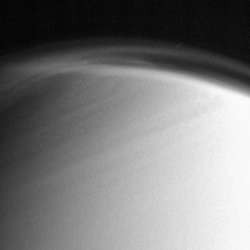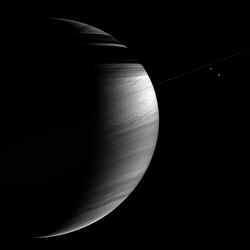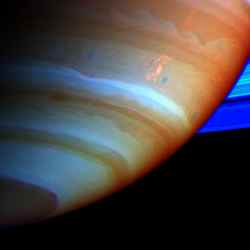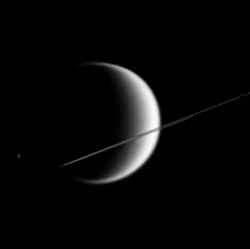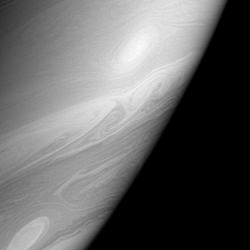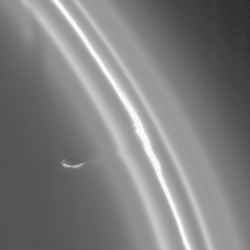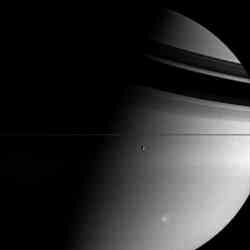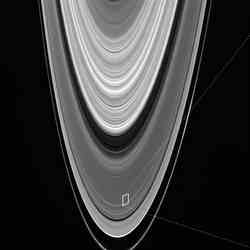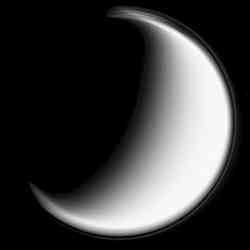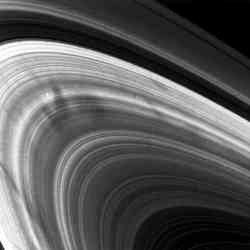
Spoke features in Saturn’s B-ring captured by Voyager 2 in August 1981. Image credit: NASA Click to enlarge
When Voyager first visited Saturn 26 years ago, it returned photographs of unusual spokelike structures in the rings. The Hubble Space Telescope confirmed the spokes in the 1990s, but then they faded out. It’s believed that the spokes are caused when electrically charged particles collect above the surface of the rings, scattering light from the Sun differently than the rings themselves. Scientists think they might be due to return around July this year, as they depend on the ring’s angle towards the Sun, which is now decreasing.
Unusual spokes that appear fleetingly on the rings of Saturn only to disappear for years at a time may become visible again by July, according to a new study spearheaded by the University of Colorado at Boulder.
The spokes, which are up to 6,000 miles long and 1,500 miles in width, were first spotted 26 years ago by the Voyager spacecraft, said CU-Boulder Professor Mihaly Horanyi of the Laboratory for Atmospheric and Space Physics. But when the Cassini spacecraft arrived at Saturn in July of 2004, the striking radial features that cut across Saturn’s ring plane were nowhere to be found — an event that disappointed and puzzled many scientists, he said.
The Hubble Space Telescope occasionally observed the ring spokes in the late 1990s, said Horanyi, a professor of physics at CU-Boulder. But the spokes gradually faded, a result of Saturn’s seasonal, orbital motion and its tilted axis of rotation that altered the light-scattering geometry.
“The spokes were switched off by the time Cassini arrived,” said Horanyi. “We think it is a seasonal phenomena related to the sun rising and setting over the ring plane that changes the physical environment there, making it either friendly or hostile to their formation.”
A paper on the subject appears in the March 17 issue of Science magazine. The paper was authored by doctoral student Colin Mitchell and Horanyi of CU-Boulder’s LASP, Ove Havnes of the University of Trosmo in Norway and Carolyn Porco of the Space Science Institute in Boulder.
The spokes are made up of tiny dust particles less than a micron in width — about 1/50th the width of a human hair — that collect electrostatic charges in the plasma environment of the rings and become subject to electrical and magnetic forces, said Horanyi. The right conditions cause them to gain an extra electron, allowing them to leap en masse from the surface of ring debris for brief periods, collectively forming the giant spokes that appear dark against the lit side of the rings and bright against the unlit side of the rings.
The researchers hypothesize that the conditions for the spokes to form are correlated to a decrease in the angle of the ring plane to the sun. “Because the rings are more open to the sun now than when Voyager flew by, the charging environment above the rings has prevented the formation of the spokes until very recently,” the researchers wrote in Science.
Cassini first imaged a “puny version” of Saturn’s spoke rings from a distance of 98,000 miles in early September that were only about 2,200 miles in length and about 60 miles wide, said Horanyi. The team believes the spoke sighting may have been an “early bird” event.
As the ring plane angle decreases when Saturn is near its two seasonal equinoxes, the conditions appear to become more suitable for the formation of the eerie spokes, said Horanyi. Although Cassini currently is orbiting too close to the ring plane to make observations, the researchers expect the spoke activity to have returned by the time the spacecraft increases its inclination in July 2006.
Once the spokes are visible again, the research team believes there will be spoke activity for about eight years, based on the fact that it takes Saturn about 30 Earth-years to complete one orbit around the sun, said Horanyi. The eight-year period should be followed by about six-to-seven years of a spoke hiatus, he said.
The dust grains levitated by plasma during spoke-forming periods are probably hovering less than 50 miles above the rings themselves and they scatter light from the sun differently than do the rings themselves, he said.
But there are still many questions about the spokes, said Horanyi. “We don’t know if they form by rapidly expanding, or if they form all at once,” he said. During the Voyager mission, they were absent during one observation, but fully developed in a follow-up observation made just five minutes later, Horanyi said.
“This is a weird phenomena; we don’t have the full story on it yet,” he said.
Original Source: CU-Boulder News Release
